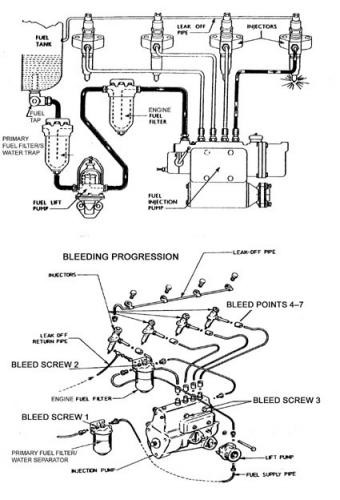Bleeding Engines - well can you?
by Sail-World on 5 Feb 2006

Fuel systems Laurence Burgin
When your engine stops and you’re far from assistance, one of the first possibilities is that it’s out of fuel. Well, that could be because a mistake was made(guess who?), but there are also many other reasons. Maybe there’s water in the fuel, or maybe that last batch of fuel had imperfections, or maybe there’s been a leak in the fuel line or a loose connection causing air to enter the system.
Whatever the case, the engine will need to be bled before it will start again. To gain a modicum of autonomy, and to get the sailing party home as soon as possible, it is a sensible idea to be able to do this independently.
Laurence Burgin of
Marine Stainless gives these clear instructions on how to bleed your engine:
‘To bleed the fuel system, or part thereof, means to remove all the air from the fuel lines and chambers in the system. This is done by pumping fuel through the lines and venting the air/fuel from various bleed points in the system
‘Always follow the progression of bleeding as shown in Fig B on next page.
‘To pump the fuel you must first operate the lift pump to bleed the low pressure side of the system. The lift pump must be pumped many times to ensure complete bleeding. Ensure your lift pump works well. After market bleeding pumps can be fitted.
‘If pump does not operate (lever slack), check if rocker arm is depressed. Turn engine over and try again.
‘First bleed primary filter by loosening bleed screw on top of housing. Holding a container under filter, pump fuel until no bubbles are visible and fuel is running freely (going everywhere!). Tighten bleed screw whilst pumping.
‘Repeat process on engine filter and fuel injection pump. Put throttle wide open in neutral and crank over engine for 25 seconds. If engine won’t start, crack one or more injectors until fuel leaks out, then tighten whilst cranking over engine. If engine still won’t start, repeat entire bleeding process.
‘Note: Some CAV-type fuel filters retain air in the head of the filter after bleeding. It may be necessary to bleed the secondary filter first and work backwards.
Have plenty of rags and fuel clean-up equipment on hand. This is a messy job. Put oil-sorb log in bilge.’
This and many other secrets from
Marine Diesel Secrets, a downloadable Treasure about your Diesel Engine.
This week’s sailing story:
The Isle of Man is a small island in the Irish Sea, populated by Vikings many winters ago. The story goes that the press gangs of old paid 10 shillings for an Englishman but one pound for a Manxman as they were such able seamen, and the strong sailing history and culture is still evident all over the island today.
I found this story on yellowed paper in a Manx Museum, date unknown, but definitely before the 20th Century, and it is here translated from the Gaelic:
Traa-dy-Liooar (Time Enough)
The following anecdote illustrates its meaning:
Scene: Peel Harbour, Isle of Man
Speakers: The Skipper, his son Mosey, and the Crew, Thias, out at sea.
Skipper: “Will we take a slant out now Mosey?”
Mosey: (scanning the horizon) “Well, I dunno, father. What do thou say, Thias?”
Thias: “Well, I dunno, neither.”
Skipper: “Aw, well, time enough, we’ll hol’ on a bit.”
After a smoke the ol’ man asks them again, and then he says to “hol’ on for another lil while”
Once more he approaches the subject “Will we take a slant out now Mosey?”
Mosey: (Scanning the horizon) “Well, I dunno, Father, what do thou say, Thias?”
Thias: “We can’t now, man, we’ve took the groun’.”
All: “Aw pity”
Not much changes over the centuries in the sailing world it seems – I can recall a similar incident in Sydney Harbour during a race just a short few years ago.
If you want to link to this article then please use this URL: www.sail-world.com/21589